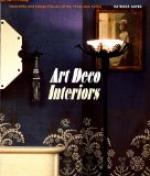So much for outline. Now for the decoration of the three periods.
Remember that the Louis XIV, XV and XVI periods took their ideas for decoration from the Greeks, via Italy, and the extreme Orient. A national touch was added by means of their Sevres porcelain medallions set into furniture, and the finely chiselled bronzes known as ormoulu, a superior alloy of metals of a rich gold colour. The subjects for these chiselled bronzes were taken from Greek and Roman mythology; gods, goddesses, and cupids the insignia of which were torches, quivers, arrows, and tridents. There were, also, wreaths, garlands, festoons and draperies, as well as rosettes, ribbons, bow-knots, medallion heads, and the shell and acanthus leaf. One finds these in various combinations or as individual motives on the furniture of the Louis.
PLATE XIX
Shows the red-tiled
entrance hall of a duplex apartment in New
York.
On the walls are two
Italian mirrors (Louis XVI), a side table
(console) of the same
epoch, and two Italian carved chairs.
[Illustration: Entrance Hall in New York Duplex Apartment. Italian Furniture]
The backgrounds for these mounts were the woods finely inlaid with ivory shell and brass in the style of the Italian Renaissance. Oriental lacquer and painted furniture, at that time heavily gilded.
The legs of chairs, sofas and tables of the Louis XIV period were cabrioles (curved outward)—a development of the animal legs of carved wood, bronze or gold, used by the ancient Assyrians, Egyptians and Greeks as supports for tables and chairs. Square grooved legs also appeared in this type.
The same grooves are found on round tapering legs of Louis XVI’s time. In fact that type of leg is far more typical of the Louis XVI period than the cabriole or square legs grooved, but one sees all three styles.
Other hallmarks of the Louis XVI period are the straight outlines, perfectly balanced proportions, the rosettes, ribbon and bow-knot with torch and arrows in chiselled bronze.
That all “painting and sculpture sang of love” is as true of Louis XVI as of Louis XV. In both reigns the colouring was that of spring-tender greens, pale blossoms, the grey of mists, sky-blues, and yellows of sunshine.
During Louis XV’s time soft cushions fitted into the sinuous lines of the furniture, and as some Frenchman has put it, “a vague, discreet perfume pervaded the whole period, in contrast to the heavier odour of the First Empire.”
The walls and ceilings of the three Louis were richly decorated in accordance with a scheme, surpassing in magnificence any other period.
An intricate system of mouldings (to master which, students at the Ecole des Beaux Arts, Paris, must devote years) encrusted sidewalls and ceilings, forming panels and medallions, over-doors and chimney-pieces, into which were let paintings by the great masters of the time, whose subjects reflected the moods and interests of each period. The Louis XV and XVI paintings are tender and vague as to subject and the colours veiled in a greyish tone, full of sentiment.




